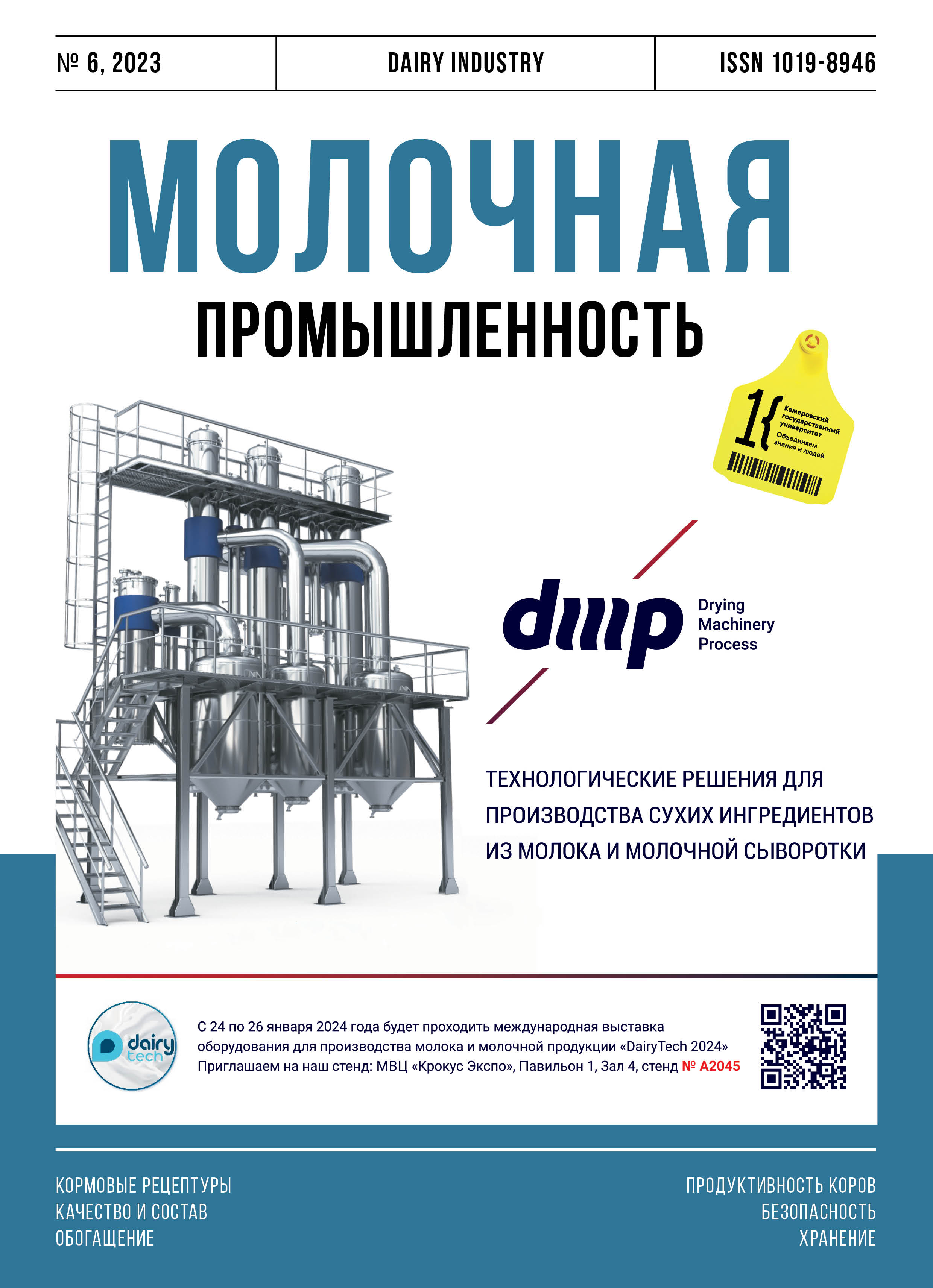Углич, Россия
Технологии молочных продуктов непрерывно совершенствуются, расширяется ассортимент, в производство вовлекаются новые пищевые ингредиенты, используются новые физические методы обработки. В этих направлениях работают тысячи ученых и технологов всего мира, а наиболее важные результаты их работ публикуются во множестве специализированных журналов. Познакомиться со всеми работами практически невозможно из-за их огромного количества, а зачастую и их отсутствия в открытом доступе. Для координации действий исследователей и производителей молочной продукции создаются и успешно функционируют различные международные и региональные сообщества. Это позволяет их членам быть в курсе основных мировых тенденций развития молочной промышленности. Тем не менее существует и множество опубликованных оригинальных работ, остающихся вне поля зрения исследователей. Цель обзора – привлечь внимание исследователей и технологов к новым разработкам в области молочной промышленности, информация о которых публикуется в высокорейтинговых мировых журналах первой и второй квартили.
молочные продукты, инновационные технологии, методы исследований, безопасность, качество.
1. The IDF global Carbon Footprint standard for the dairy sector. Bulletin of the IDF, No. 520. International Dairy Federation (ed.). - Brussels, 2022.
2. Zhou, S. A narrative review of vitamin K forms in cheese and their potential role in cardiovascular disease/ S.Zhou, B.M.Mehta, E.L.Feeney// International Journal of Dairy Technology. 2022. V. 75(4). P. 726-737. doi:https://doi.org/10.1111/1471-0307.12901
3. Liu, Y. Current progress of emerging technologies in human and animals’ milk processing: Retention of immune-active components and microbial safety/ Y.Liu [et al.]// Comprehensive Reviews in Food Science and Food Safety. 2022. V. 21. P. 4327-4353. https://doi.org/10.1111/1541-4337.13019
4. Urgu-Ozturk, M. Possibilities of using the continuous type of UV light on the surface of lor (whey) cheese: Impacts on mould growth, oxidative stability, sensory and colour attributes during storage/ M.Urgu-Ozturk// Journal of Dairy Research. 2022. V. 89(3). P. 335-341. https://doihttps://doi.org/10.1017/S0022029922000590
5. Ali, F. Nonthermal and thermal treatments impact the structure and microstructure of milk fat globule membrane/ F.Ali// International Journal of Dairy Technology. 2022. V. 75. P. 338-347. https://doi.org/10.1111/1471-0307.12840
6. Du, Y. Improving food drying performance by cold plasma pretreatment: A systematic review/ Y.Du [et al.]// Comprehensive Reviews in Food Science and Food Safety. 2022. V. 21. P. 4402-4421. https://doi.org/10.1111/1541-4337.13027
7. Nunes, B.V. Microbiological Inactivation by Ultrasound in Liquid Products/ B.V.Nunes [et al.]// Food Bioprocess Technology. 2022. V. 15. P. 2185-2209. https://doi.org/10.1007/s11947-022-02818-z
8. Scudino, H. Raw milk processing by high-intensity ultrasound and conventional heat treatments: Microbial profile by amplicon sequencing and physical stability during storage/ H.Scudino [et al.]// International Journal of Dairy Technology. 2022. V. 75. P. 115-128. https://doi.org/10.1111/1471-0307.12819
9. James, G.Z. Microstructural changes in acid milk gels due to temperature-controlled high-intensity ultrasound treatment: Quantification by analysis of super-resolution microscopy images/ G.Z.James [et al.]// International Journal of Dairy Technology. 2022. V. 75. P. 321-328. https://doi.org/10.1111/1471-0307.12838
10. Wang, W. Effect of high hydrostatic pressure processing on the structure, functionality, and nutritional properties of food proteins: A review/ W.Wang [et al.]// Comprehensive Reviews in Food Science and Food Safety. 2022. V. 21. P. 4640-4682. https://doi.org/10.1111/1541-4337.13033
11. Gharbi, N. Factors affecting the modification of bovine milk proteins in high hydrostatic pressure processing: An updated review/ N.Gharbi, A.Marciniak, A.Doyen// Comprehensive Reviews in Food Science and Food Safety. 2022. V. 21. P. 4274-4293. https://doi.org/10.1111/1541-4337.13012
12. Gentès, M.-C. Potential applications of pulsed electric field in cheesemaking/ M.-C.Gentès, A.Caron, C.P.Champagne// International Journal of Dairy Technology. 2022. V. 75. P. 270-288. https://doi.org/10.1111/1471-0307.12854
13. Blais, H.N. A review of multistage membrane filtration approaches for enhanced efficiency during concentration and fractionation of milk and whey/ H.N.Blais, K.Schroën, J.T.Tobin// International Journal of Dairy Technology. 2022. V. 75. P. 749-760. https://doi.org/10.1111/1471-0307.12884
14. Kara, Ü. The use of microfiltration technique in the production of skim milk powder: The effect of milk transport conditions on the microbiological and physicochemical properties of milk and milk powders/ Ü.Kara, D.Sert// International Journal of Dairy Technology. 2022. V. 75. P. 438-447. https://doi.org/10.1111/1471-0307.12855
15. Xia, X. Production, composition and preservation of micellar casein concentrate and its application in cheesemaking: A review/ X.Xia [et al.]// International Journal of Dairy Technology. 2022. V. 75. P. 46-58. https://doi.org/10.1111/1471-0307.12829
16. Ong, L. New Insights into Cheese Microstructure/ L.Ong [et al.]// Annual Review of Food Science and Technology. 2022. V. 13(1). P. 89-115.
17. Silva, L.K.R. Application of infrared spectroscopic techniques to cheese authentication: A review/ L.K.R.Silva, L.S.Santos, S.P.B.Ferrão// International Journal of Dairy Technology. 2022. V. 75. P. 490-512. https://doi.org/10.1111/1471-0307.12859
18. Surber, G. The Role of Exopolysaccharide-Producing Streptococcus thermophilus on Physical Properties of Stirred Skim Milk Gel/ G.Surber, H.Rohm, D.Jaros// Dairy. 2022. V. 3. P. 761-775. https://doi.org/10.3390/dairy3040052
19. Tripaldi, C. Effect of Storage and Heat Treatment of Milk Destined for Cheese Production on Its Oxidative Characteristics/ C.Tripaldi [et al.]// Dairy. 2022. V. 2. P. 585-601. https://doi.org/10.3390/ dairy2040046
20. Zago, M. Raw Milk for Provolone Valpadana PDO Cheese: Impact of Modified Cold Storage Conditions on the Composition of the Bacterial Biota/ M.Zago [et al.]// Dairy. 2022. V. 3. P. 700-709. https://doi.org/10.3390/dairy3040048
21. Grujović, M.Ž. Advantages and disadvantages of non-starter lactic acid bacteria from traditional fermented foods: Potential use as starters or probiotics/ M.Ž.Grujović [et al.]// Comprehensive Reviews in Food Science and Food Safety. 2022. V. 21. P. 1537-1567. https://doi.org/10.1111/1541-4337.12897
22. Oh, H.E. Use of biosensor technology in analysing milk and dairy components: A review/ H.E.Oh, S.Eathorne, M.A.Jones// International Journal of Dairy Technology. 2022. V. 75. P. 738-748. https://doi.org/10.1111/1471-0307.12900
23. Mei, Y. Electrochemical Biosensors for Foodborne Pathogens Detection Based on Carbon Nanomaterials: Recent Advances and Challenges/ Y.Mei [et al.]// Food Bioprocess Technology. 2022. V. 15. P. 498-513. https://doi.org/10.1007/s11947-022-02759-7
24. Charneco, G.O. Bacteriophages in the Dairy Industry: A Problem Solved?/ G.O.Charneco [et al.]// Annual Review of Food Science and Technology. 2023. V. 14(1).
25. Ye, J. Phage-based technologies for highly sensitive luminescent detection of foodborne pathogens and microbial toxins: A review/ J.Ye [et al.]// Comprehensive Reviews in Food Science and Food Safety. 2022. V. 21. P. 1843-1867. https://doi.org/10.1111/1541-4337.12908
26. Li, L. Single-chain fragment variable produced by phage display technology: Construction, selection, mutation, expression, and recent applications in food safety/ L.Li [et al.]// Comprehensive Reviews in Food Science and Food Safety. 2022. V. 21. P. 4354- 4377. https://doi.org/10.1111/1541-4337.13018






